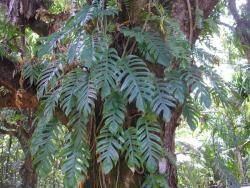I decided I would go ahead and post the scientific article that likely lead to the conclusion Epipremnum aureum and Epipremnum pinnatum are one and the same along with a brief explanation.
As you will see there is a cultivar name in single quotes after the name Epipremnum pinnatum. Epipremnum aureum has since been divided out as a unique species and not one and the same as Epipremnum pinnatum. If you visit the Royal Botanic Garden Kew website CATE Araceae you will find the two are distinct.
http://www.cate-araceae.org/in...
.
Since this article describes Epipremnum aureum many people drew a bad conclusion thinking this plant is only a variation of Epipremnum pinnatum.
The plant many of us grow as "Pothos" is actually Epipremnum aureum but even that is a variation, The wild plant does not normally have the variegation and the blades appear somewhat different in the wild as well. The other names are synonyms.
This is technical but worth reading. The more any collector learns to understand a scientific description the more you learn about your plants. The Oxford Botanical Dictionary will help you understand all these terms and can be purchased cheaply on Amazon.com
Steve
Epipremnum pinnatum 'Aureum'
Epipremnum pinnatum (L.) Engl. 'Aureum' (see Nicolson, Allertonia 1 (1978) 347.) -- Pothos aureus Linden & André, Ill. Hort. 27 (1880) 69. -- Scindapsus aureus (Linden & André) Engl. in Engl., Pflanzenr. 37 (IV.23B) (1908) 80. -- Rhaphidophora aurea (Linden & André) Birdsey, Baileya 10 (1963, ‘1962’) 159 --
[Rhaphidophora aurea (Linden & André) Furtado, Gard. Bull. Singapore 20 (1964) 379, comb. superfl.]
Epipemnum aureum (Linden & André) G.S. Bunting, Ann. Missouri Bot. Gard. 50 (1964, ‘1963’) 28. --
Type: Ill. Hort. 27 (1880) pl. 381. Epipremnum mooreense Nadeaud, J. de Botanique 13 (1899): 6. Type: ****, Nadeaud s.n. (P holo!)
Very large root-climber to 16 m. Pre-adult plant usually forming modest terrestrial colonies. Adult plant with stem 5--40 mm diam., internodes 2--30 cm long, separated by prominent leaf scars, with prominent irregular whitish longitudinal crests, older stems with distinctive matt to sub-lustrous orange-brown papery epidermis growing stems mid-green to pale yellow-green, occasionally with obscure large dull yellow to white variegations. Flagellate foraging shoots common, these arising high in the canopy and reaching the ground. Aerial roots of two types, clasping roots densely arising from nodes and internodes, feeding roots prolific, both strongly adherent to substrate and free, both root types pubescent, mid- to dark brown, growing tip pale brown-yellow, feeding roots later prominently lenticellate. Cataphylls and prophylls soon drying and then degrading to netted sheaths, these sparsely clothing upper stem and mostly soon falling. Foliage leaves scattered on lower stem, becoming clustered distally. Petiole 19.5--50 cm x 3--15 mm, canaliculate, smooth, mid-green to rather bright yellow-green, airdrying mid- to dark brown; apical geniculum 16--50 x 3--8 mm, smooth, basal geniculum 3--7 x 1--1.5 cm, both genicula barely on not greater in diameter than petiole; petiolar sheath extending to up to mid-way along apical geniculum, at first sub-membranaceous, soon drying chartaceous and degrading to untidy, slightly netted weak fibres, then falling to leave a smooth, mid-brown scar. Lamina 10--93 x 5--60 cm, entire to irregularly pinnatifid, ovate to elliptic in outline, sub-coriaceous, apex acute to acuminate, base moderately cordate, divisions pinnatifid to pinnatipartite; pinnae up to half the length of the lamina wide, apex truncate; terminal pinna, if present, smooth-margined, some leaves with few minute pellucid dots adjacent to the midrib in leaves, pellucid dots rarely
perforating and almost never enlarging, lamina dull to somewhat glossy mid-green; slightly paler beneath, usually irregularly yellow or white variegated, rarely entirely mid-green; pinnae each with 1 (very rarely more except for the terminal pinna) compound primary lateral vein and several to rather many interprimary veins, these diverging from midrib at c. 70°, individual elements of the compound vein diverging at c. 10° from various points along the pinna, the vein thus becoming finer towards the margin; interprimary and secondary venation mostly remaining sub-parallel to compound primary vein, some weaker elements further dividing and becoming sub-reticulate, all other higher order venation conspicuously reticulate, midrib impressed above, very prominently raised beneath, lower order venation slightly impressed to almost flush above, variously raised beneath, higher order venation flush above, flush or nearly so beneath in fresh material but raised and rather conspicuous in dried specimens.
Inflorescences several together, first inflorescence subtended by a usually fully developed foliage leaf and a swiftly disintegrating cataphyll, at anthesis partially to almost completely exposed. Peduncle c. 6 cm x 10--15 mm, stout, terete, pale green to yellow-green. Spathe canoe-shaped, shortly acuminate, spreading wide at anthesis and margins reflexing, c. 15 cm x 6--7 cm when pressed flat, exterior green, later whitish, interior whitish, airdrying dark brown. Spadix 17--19 x 2--3 cm, sessile, cylindrical, bluntly tapering towards the apex, base slightly obliquely inserted, whitish, air-drying almost black. Flowers 3--5 mm diam.; ovary 4--6 x 3--5 mm, cylindrical, basal part slightly compressed; ovules 2 ; stylar region 3--5 x 2.5--5.5 mm, trapezoid, rather robust, apex flattened, margins somewhat raised in dry material; stigma linear, 2--6 x 0.1--0.5 mm, longitudinal; stamens 4; filaments c. 6 x 0.5 mm; anthers narrowly ellipsoid, c. 1.5 x 0.75--1 mm;.Distribution - Unknown in the wild, alleged to have originated in the Solomon Islands.
